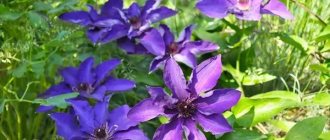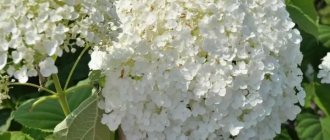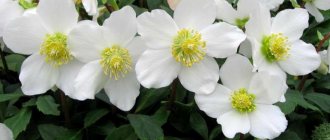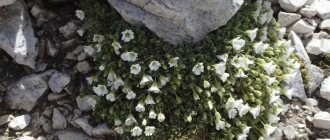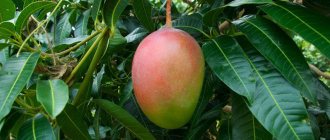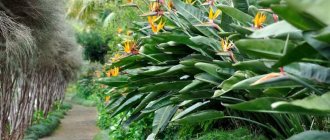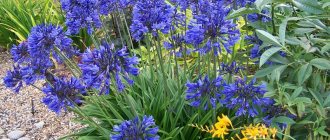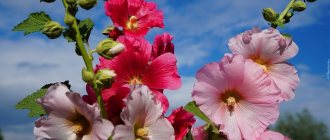This aromatic herb is known to many. Common thyme is widely used as an aromatic seasoning in the kitchen; the medicinal effect of this plant is also known, which is used in the treatment of many diseases. Not only its beneficial properties, but also the fact that it is an undemanding plant, make it popular for growing in the garden or in a pot at home. We will tell you how to grow thyme - planting and care in open ground and in pots, secrets of growing.
Creeping thyme description photo
Thyme, thyme or Bogorodskaya grass is a perennial plant with recumbent shoots. The leaves are 5 to 10 mm long and have the shape of an ellipse. They are located on a short petiole. Grows in dense masses (bushes) up to 30 cm high; compact capitate inflorescences. The stems spread densely along the ground, forming a dense carpet.
Depending on the region, thyme blooms in May or June. In August-September, fruits are formed: small nuts measuring 0.6 mm. Creeping thyme photo of the plant during the flowering period.
Biological characteristics of the plant
Creeping thyme (“Bogorodskaya grass”) belongs to the group of perennial herbaceous plants of the Lamiaceae family.
This is a miniature bush 15-20 centimeters high, with creeping (creeping) stems, which, as they grow, create a picturesque carpet. The stems at the bottom become woody. The shape of the plant is often petiolate - lateral stepsons grow from one shoot, on which flowering will later begin. The leaves are ovate, bright green, medium in size, up to one centimeter long. Along the edges, the leaves have deep, even teeth, cutting the plate almost in half.
Thyme blooms with small, pale lilac flowers, which are collected in large capitate inflorescences.
Volumetric loose inflorescences are located at the very top of the stems. After flowering, the fruit remains, which consists of four medium-sized nuts. Thyme has a strong aromatic odor. Blooms in June-July. By the way! It is creeping thyme that landscape designers use for landscaping garden areas.
Origin
Thyme is a cult ornamental plant, known since pagan times. According to pagan legend, God created a forest in which everything was beautiful and sickly sweet. Then he created bitter herbs to maintain balance. Thanks to essential oils, dried thyme retains its aroma for a long time.
The herb was part of incense and was used in worship. The divine plant could not only cure, but also revive a person. In the wild it grows in areas with temperate climates. Due to the gradual disappearance of the crop from the natural environment, there is a need for its artificial cultivation.
Reviews
Maria
Thyme is known to me primarily for its medicinal properties. This fragrant herb is great for coughs. Therefore, in our house there is always a bag of dry herbs, which we brew as soon as one of the family members starts to get sick. Mom told me that previously newborn children were bathed in water to which thyme was added. It turned out that many people grow thyme in the garden as a flower crop. Indeed, the plant is not capricious. It is not “offended” by lack of water and grows well in the shade. In general, if you want to decorate your garden, then thyme is the best candidate for this.
Elizabeth
We live in the countryside, and the fields around our village are completely covered with thyme. We have different species growing here, but the creeping one is the most beautiful. It spreads like a carpet along the slopes of the hills and grows beautifully along the banks of rivers. In mid-summer, everything around is covered with small purple flowers, which emit a strong herbal aroma that can be felt even at home. I heard that landscape designers hold this grass in high esteem. It is not surprising, because thyme is such a viable herb that it can withstand multi-day droughts and the invasion of all kinds of pests. And illnesses do not concern her at all. In fact, it is a very good herb, and most importantly healthy.
Useful properties of thyme
Thyme leaves and stems contain many active substances:
- essential oil;
- resins;
- tannins;
- flavonoids;
- bitterness;
- mineral salts.
The composition is rich in useful acids: ursolic, caffeic, quinic, thymunic, oleonolic, chlorogenic. Due to the chemical composition of thyme, it is used for medicinal purposes. Decoctions and tinctures of thyme are used as an antipyretic, diuretic, anticonvulsant and sedative.
In addition, the plant is widely used in cooking, providing dishes with aroma and unique taste. Thyme is a honey plant. Apiaries are located close to the growing areas. The nectar produces fragrant honey.
Kinds
The genus contains more than 200 species.
Within the species there are 2 subspecies:
- vulgaris – nominative subspecies,
- aestivus (Willk.) - known from Spain.
The most common:
- Creeping thyme (Thymus serpyllum L.).
- T. Marshall (Thymus marschallianus Willd.).
- Some species are listed in the Red Book - T. beautiful (Thymus pulchellus) and T. Taliev (Thymus talijevii).
There are mainly 2 types used in cooking:
- Common (Thymus vulgaris);
- Lemon-scented (Thymus citriodorus).
Let's take a closer look at them.
Ordinary
Common thyme (Thymus vulgaris) is a plant with rigid, erect stems, from which small, narrow, elliptical, gray-green leaves grow in pairs. The leaves are sometimes rusty-red below, the length does not exceed 5-10 mm. It blooms with pink and white flowers growing in a spiral at the ends of the branches, making the plant extremely attractive to insects, especially bees. It is characterized by a sharp, refreshing taste and spicy, bright aroma.
Common thyme, photo
Creeping
Creeping thyme (Thymus serpyllum) is a low creeping evergreen shrub, reaching a height of 5 cm. This species is a dwarf plant, the lower part of the shoots becomes woody. Leaves and stems of inflorescences grow from woody stems. The tips of the thin creeping shoots that take root at the nodes are raised upward, creating a smooth and low mat.
In May, when purple inflorescences grow above the total mass of leaves, the plant gains approximately 10 cm in height. Blooms massively from late May to June. Then there are not so many inflorescences. The flower color is purple-pink, sometimes white flowers are found.
The leaves are small, numerous, and form a dense green carpet. During flowering, the plant likes full sun, but in later summer it likes some shade.
It does not make any special demands on the soil, although it loves poorer soils with some sand. Perennials are not fertilized. With age, like most creeping plants, thyme tends to grow. The only labor-intensive procedure is summer cutting of inflorescences; it is important to cut only the non-woody parts, because a plant that is cut too much will not grow back, leaving a dried hole on the green carpet.
The plant is completely frost-resistant, but in snowless, very cold, windy winters it may not survive without shelter. The species is ideal for turfing sunny, sandy areas where other plants cannot cope - for example, between pavement slabs.
Lemon-smelling
Lemon thyme (Thymus citriodorus), sometimes called lemon thyme, is a cross of garden thyme and wild thyme. Grows up to 15 cm, green leaves. The name of the plant is given because of the characteristic lemon smell released by the leaves. It blooms in June with pink flowers collected in loose inflorescences that attract butterflies and bees. Growing is easy, and the lemon-scented thyme itself is an ideal plant for sodding and creating a decorative ground cover. Can be grown, for example, in rocky gardens.
Lemon-scented thyme, photo
Thyme when planted in open ground
Thyme is planted in open ground with the onset of the warm season. The temperature at night should not fall below +13°C. During the day, reach at least 20°C.
Important! Planting and caring for thyme requires a careful approach to choosing a location.
Site selection, soil
The landing site should be well lit by the sun. In the absence of one, it can grow in partial shade. However, it will stretch upward and grow poorly. The planting site is carefully dug up, humus and compost are added. Dense soil should be loosened. Thyme grows well in low acidity soil. In case of increased acidity, wood ash, chalk or dolomite flour is added.
Thyme is an unpretentious plant. There is no need for constant soil enrichment. It is enough to add compost and humus in the first year of life. In the second year, mineral fertilizers are applied. If wood ash is added, the soil does not need fertilizer.
Possible problems and their solutions
One of the common problems encountered when growing thyme in open ground is the death of seedlings during the year, which led to the opinion that the plant has a one-year lifespan. But that's not true.
Possible reasons for this behavior of the crop may be unprepared soil, that is, dense and depleted, or abundant watering, in which the roots of the shoots rot, causing death. Solving these problems is not difficult. It is enough to add drainage to the ground when planting and add nutrients, and during the process of growing the planted bushes do not fill them with water.
When growing seedlings, young seedlings can become very elongated. This may be caused by insufficient light. To avoid this problem, experts recommend immediately placing them on the south side of the room after the first shoots appear. Only there will the seedlings receive the necessary portion of the sun for further high-quality development.
Thyme planting
Thyme - planting and care differ depending on the method of growing outdoors, in a greenhouse, or indoors. Growing conditions also depend on the type of climate and soil.
In open ground
Seedlings are planted in open ground. When planting, a distance of 20-25 cm is left between seedlings. If the planting area is large, rows are marked, the distance between which is 40-50 cm. Seedlings are grown from seeds or purchased in a specialized store.
Thyme is planted by seeds in open ground only in warm regions. The sunny and warm period should be 7-9 months a year. In regions with shorter warm periods, seedlings grown indoors are planted in open ground.
In closed ground
You can grow thyme in a greenhouse from seeds as long as the seedlings need protection from the cold. The greenhouse effect creates the necessary conditions for germination and strengthening of sprouts. Planting takes place in March.
At the end of April, they look at the state of the seedlings and the prevailing weather conditions. With the onset of warm weather, seedlings are planted in open ground. In a greenhouse in warm weather, thyme feels uncomfortable. The stems wither and the leaves curl. Moisture in the soil may stagnate.
Planting should be protected with a covering structure when growing crops in environmentally unfavorable areas. For these purposes, the roof of the greenhouse is left covered. The walls of the greenhouse are opened to allow maximum air flow.
Thyme care
Creeping thyme, the care of which is not very difficult, requires several mandatory measures.
Regular weeding
Weeds have a more powerful root system and can choke thyme. The problem exists in young plants. An adult thyme that spreads like a carpet can itself suppress the growth of weeds.
Loosening
Moisture will not stagnate in the roots. The top layer of soil, when drying out, will not form a hard crust.
Trimming
At the end of flowering, the shoots are cut by two-thirds before lignification begins. This is necessary to rejuvenate the bush.
Frost protection
Despite its resistance to cold weather, in regions with frosty winters the crop is covered with fallen leaves or peat. In regions with guaranteed snowy winters, covering is not required. The grass overwinters well under snow.
In warm regions, the plant does not need shelter at all. Thyme tolerates the cold season well. If possible, melt water should not be allowed to stagnate in the area where the crop grows. It is recommended to plant overgrown rugs every two years. Thyme is getting crowded. It blooms less. The flowers become smaller.
Watering
The plant does not need frequent watering. In moderately rainy summers, watering once or twice a week is sufficient. During periods of high humidity it is not recommended at all. When growing in moist soils, good drainage must be ensured. The plant tolerates drought better than waterlogging.
Top dressing
The plant needs to be fertilized a year after planting. To do this, use the usual fertilizer scheme: superphosphate 20-30/potassium salt/ammonium sulfate - 15-20 g/m². If you grow a plant for its leaves, use a fertilizer with a high nitrogen content.
Harm and contraindications
Despite the benefits of creeping thyme, in some cases it can cause harm to health. It should not be used to treat children under two years of age. Long-term use of drugs based on it can lead to the development of Graves' disease, caused by hyperfunction of the thyroid gland.
Contraindications:
- pregnancy;
- renal, heart failure;
- period of exacerbation of the ulcer.
Important! If it is necessary to use thyme during lactation, feeding should be temporarily stopped until the end of the course of therapy.
Reproduction methods
The plant reproduces in three ways:
- cuttings;
- seeds;
- dividing the bush.
Cuttings are cut in late spring before flowering. Shoots with buds and flowers take root worse. Length of shoots: 5-8 cm. The cut cuttings are stuck into the ground, moderately moistened, not allowed to dry out or become waterlogged.
It is best to propagate the bush by division in the spring. The dug up bush is divided into several parts with a knife and rooted. Propagation by seeds is the most convenient way. Seeds are produced in large quantities and produce numerous shoots.
Growing thyme by seeds
Thyme has a small seed. A container growing option is suitable for this method. For planting, the seeds are kept in a wet cloth or water for 10-12 hours. Mix with sand, which provides them with good drainage.
Sow in a container, which is placed indoors in a well-lit place. Seeds should not be buried deep into the soil. The depth of seed placement should not be more than 0.5 cm.
Growing thyme with seeds directly in open ground is a long process, which is not always possible in the climatic conditions of many regions. In addition, the plants will bloom only in a year.
To independently harvest seeds, several bushes are left untouched. Inflorescences and cuttings are not cut from them. In autumn, the tops of abandoned plants turn brown. The branches are cut from them and dried for 7-10 days in a well-ventilated place protected from the sun. Then the seeds are separated. The shelf life of seeds for sowing is 2-3 years.
At home
Creeping thyme is planted in ready-made soil for cacti or universal soil with the addition of 1:3 perlite or sand. Seeds can be pre-kept for several hours in a growth stimulator. To sow seeds, a rectangular container with a height of 9-10 cm is required. Fill the container with soil. Sow the seeds and lightly sprinkle with soil. Water from a spray bottle with water at room temperature. The container is covered with plastic wrap and left at a temperature of 18-20°C.
For a container with planted seeds, choose a sunny place. Treated seeds will germinate in 2-2.5 weeks. The germination period of untreated ones is from three weeks. The soil in the container must be moistened and not allowed to dry out. After germination, the container is shaded.
When plants have 2-3 leaves, they are planted in cups of 3 seedlings. After two months, they are transplanted into a ceramic pot with a drainage hole. The volume should be at least 4 liters, with a diameter of 25 cm. Thyme, planting and care for which is similar to rosemary, can be grown with it in the same container. Plants do not conflict with each other.
In the open ground
For planting in open ground, preliminary germination of seeds indoors is required. In mid-late March, seeds are sown in a container. In May, seedlings are planted in the ground. In warm regions, planting seeds directly into the ground is allowed. It is recommended to cover the beds with plastic film to create a greenhouse effect. Disadvantage of this method:
- late shoots;
- freezing of seeds/seedlings;
- erosion of beds by streams of rainwater.
Thyme - planting and care in open ground involves planting seedlings. This way you can get flowering in the year of planting. In good conditions, thyme reproduces by self-sowing. For many gardeners, this method is the most convenient and economical. Flowering in this case occurs after a year.
Thyme planting and care
Thyme: planting and care may vary depending on the region of growth. The main differences are due to climatic conditions.
In outskirts of Moscow
The Moscow region has a temperate continental climate. The region is characterized by warm, dry summers and frosty, snowy winters. In most of the Moscow region, soddy-podzolic soils predominate. In the south and southwest of the region, slightly acidic ones predominate. The land is suitable for growing thyme. Basic planting recommendations:
- Choose a sunny place for planting.
- In the fall, dig up and clear of roots, dead wood, and weeds.
- Feed the soil. Depending on the composition of the soil, manure and mineral fertilizers can be used.
- The seeds are sown in March and covered with film.
- Planting of seedlings is carried out in April/May.
- The crop is planted in rows with a gap of 40 cm between them.
The age of seedlings for planting in open ground is approximately 70 days. For planting thyme, you can choose a place after vegetable crops. Every 5 years it is recommended to change the place of growth. Planting and caring for thyme in the Moscow region involves propagating the crop by seedlings. In snowy winter conditions, the bushes are not covered.
In the middle zone
Planting and caring for thyme in central Russia has some peculiarities. The region is dominated by podzolic infertile soils. They have high acidity and are unsuitable for growing thyme. You can reduce acidity with lime (50 kg per 100 sq. m).
Central Russia is characterized by a temperate continental climate. The conditions for planting and caring for the plant are the same as in the Moscow region. Good conditions for growing in Crimea, the Caucasus, the Urals, Tatarstan, and Krasnodar Territory.
What is thyme or thyme like?
The Thyme genus includes several hundred species, distributed in the temperate climate zone of Europe, Asia and North Africa.
This is a low, from 10 to 40 cm, perennial evergreen shrub. A characteristic feature of thyme is its soft, herbaceous stems lying on the ground and only slightly rising. It grows in breadth, not upward, and often quite actively conquers the space around it.
As they grow, the stems become woody. Due to the fact that there are too many types of thyme, it is not easy to describe it. For example, leaves can be round, oval, elongated, oblong, sometimes jagged. But they are always hard and small (up to 1 cm).
Thyme blooms in summer with small white, pink or purple flowers. The beauty of thyme is that from a small piece it quickly grows into a whole clump, forming a dense cushion. And the slightest touch to it causes an explosion of smell. Despite the fact that it will not require any care from you, but will bring a lot of benefits.
Thyme is a low, from 10 to 40 cm, perennial evergreen shrub. © Igor Bilevich
Pests and diseases of thyme
Due to its pronounced odor, the thyme plant does not attract many insects. However, the plant may suffer from pests:
- aphids;
- sand sluggers;
- meadow moths;
- weevils.
Harmful insects hide on the back of the leaf, damaging young shoots, buds, and flowers. A web appears. When the first signs are detected, they are treated with insecticides: fitoverm, actellik, biotlin.
The culture is resistant to diseases. Typical diseases arise from waterlogging, planting density, excess moisture in the soil: rust, fungus, root rot. The soil is watered with fungicides and phytosporin.
Creeping thyme in landscape design
Perennial thyme is successfully used in the design of surrounding areas. The evergreen shrub is pleasing to the eye in the cold season. The bright purple-violet caps of the inflorescences combine well with other flowering shrubs. The culture is resistant to trampling. Planted along footpaths and curbs. Some options for decorating the site:
- planting in a natural landscape;
- full/partial replacement of lawn grass;
- rockery;
- rock garden;
- stone garden;
- topiary;
- mixboard.
The fragrant garden decoration is growing rapidly. Every year the bushes are put in order: pruned, thinned, planted. An annual plant is used in miniature landscape forms.
Combination with other plants
Thyme is a non-conflict plant. He tolerates any neighborhood. However, due to the characteristics of the root system, which is located close to the soil surface, it can be displaced by more “strong” neighbors. Originally combined with low-growing ornamental shrubs:
- barberry Thunberg;
- dwarf thuja;
- juniper;
- euonymus.
Among garden flowers, alpine carnation, rock alyssum, sedum, and bearded iris are well suited. The listed crops are similar in terms of growing conditions - they love sunny hills. Thyme combines in an original way with regular carnations, dahlias, and peonies.
Collection and storage
Harvesting grass involves trimming inflorescences and shoots during the growing season. Pruning is done twice: in June during flowering and in August. During flowering, the grass contains the maximum concentration of nutrients.
Important! The weak root system, located close to the soil surface, does not allow the shoots to be cut off. If you try to pull the stem, you can pull the entire bush out of the ground. When collecting shoots and inflorescences, garden shears are used.
The most suitable time for collecting herbs is considered to be days falling on church holidays: Trinity, Dormition of the Virgin. The healing properties of the herbs collected during this period are tripled.
Dry the grass in a well-ventilated room protected from direct sunlight. Under such conditions, dried thyme retains its beautiful color and spicy aroma. After drying, the grass is cut into compact branches and stored in bags made of natural fabric. Dry shoots can be crushed, ground and packaged in tins. They retain the aroma better. However, such a blank must be used for its intended purpose in the near future.
Growing thyme on a windowsill
Thyme can also be grown as a potted plant. This way you will always have seasoning at hand on the kitchen window.
A pot for the plant should be at least 15 cm in diameter. Soil is used as soil, mixed with perlite if desired. Place drainage at the bottom of the pot. The soil is moistened with a flower sprayer to keep it soft.
A few seeds are enough for planting. They need to be spread evenly over the surface, then sprinkled with a layer of soil (no more than 1 cm). Moisten the top and make sure that the surface does not dry out before the sprouts appear. Until the thyme has sprouted, the pot should be in a well-lit place, but not in direct sunlight.
After the greenery has appeared, the pot is placed on the windowsill on the south side of the house.
Thyme shoots on the windowsill
In spring and summer, the plant feels good in the sun, it just needs timely watering. Thyme can also grow in the shade, only then its aroma will not be very pronounced. In addition to watering, you can spray the greens, so they become more beautiful and the vegetative mass grows better. Fertilizing is applied once a year, the same as when growing in the ground.
Important! To form a beautiful plant with a dense arrangement of branches, shoots are pruned in the spring and after flowering. Cut with scissors to the woody part, leaving about a third of the shoot.
With the onset of autumn, even indoor thyme needs a drop in temperature. Place the pot on the balcony if it is insulated. At temperatures below 5 degrees the plant will die. Reduce the frequency of watering and stop spraying. Lighting must be sufficient. Thyme does not need darkening.
Growing thyme indoors
Prices for perlite for plants
perlite for plants
Harvesting
Thyme twigs, leaves or flowers are used in the preparation of dishes and drinks throughout the growing season. But there is also harvesting for medicinal purposes. This is done during the period of intense flowering. Young shoots with flowers and leaves are cut off and then laid out on cloth to dry. You can also tie the branches into bundles and dry them by hanging them from the ceiling.
Drying thyme sprigs for adding to tea and making a decoction
From ancient times there is a belief that the healing properties of thyme are enhanced on the day when Trinity is celebrated. Therefore, our ancestors prepared medicinal herbs on this day.
